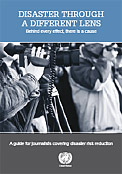66.5 million children are affected annually by disasters. Because it is difficult for them to cope with unexpected and painful interruptions to their lives, they are often more affected than adults. Victims of disaster and climate change, children and young people can and should be encouraged to participate in disaster reduction and decision making. | |
Chair’s summary third session of the Global Platform for Disaster Risk Reduction and the World Reconstruction Conference

This summary provides the Chair’s assessment of the main points of the deliberations at the Third Session of the Global Platform for Disaster Risk Reduction held in Geneva, Switzerland from 8-13 May 2011.
The Chair`s Summary reflects interventions at the Joint Outcomes Session of the Global Platform on 13 May and subsequent comments on the draft which was open until 23 May. The UNISDR secretariat has endeavoured to reflect most of the comments while at the same time respecting the need to keep the Summary succinct and action orientated.
The Chair`s Summary reflects interventions at the Joint Outcomes Session of the Global Platform on 13 May and subsequent comments on the draft which was open until 23 May. The UNISDR secretariat has endeavoured to reflect most of the comments while at the same time respecting the need to keep the Summary succinct and action orientated.
- View full document [PDF 77.82 kB]
- View full document (in French) [PDF 87.11 kB]
- View full document (in Spanish) [PDF 80.27 kB]
- View full document (in Russian) [PDF 139.54 kB]
- View full document (in Arabic) [PDF 165.77 kB]
- View full document (in Chinese) [PDF 160.92 kB]
- Date: 2011
- Sources:
- United Nations International Strategy for Disaster Reduction Secretariat (UNISDR)
Related Links
- News: Call for comments: Chair's Summary of the Global Platform for Disaster Risk Reduction 2011 and the World Reconstruction Conference
- News: 'Disaster risk reduction key to preserving and protecting environment, ensuring sustainable development - Global Platform Chair's summary
Keywords
- Themes:
- Climate Change, Early Warning, Media, Recovery, Risk Identification & Assessment, Urban Risk & Planning, Governance, Economics of DRR, Structural Safety, Vulnerable Populations
Disaster through a different lens: behind every effect, there is a cause

Behind every effect, there is a cause:
This manual for the media - compiled by journalists and disaster experts who understand that disaster risk reduction is a civic duty, government responsibility, national obligation and a good story - is for reporters and broadcasters who want to know more about those urgent, terrifying and all-too-often tragic moments when the fabric of national and civic government encounters the forces of nature.
It asserts the importance of the role of newspapers, radio, television and other media in creating awareness and disseminating information about disasters. Reporters, commentators and broadcasters, can do more than just inform and raise awareness about disasters. They can make a real difference in the way people think and act, especially now when climate change is recognized as a major challenge that will aggravate our vulnerability to disasters.
The chapters address:
- What you need to know about disaster risk reduction (DRR)
- Disaster risk reduction in the media
- DRR lessons from four disasters: Indian Ocean tsunami; Mt. Pinatubo, Philippines; Hurricane Katrina, USA; Kashmir earthquake, Pakistan
- Useful information on natural hazards
- Disaster risk reduction resources
The conclusion includes: Annexes on a brief history of the evolution of disaster risk reduction, terminology, and how corruption costs lives; a Bibliography.
- View full document [PDF 5.87 MB]
- View full document (in Arabic) [PDF 2.04 MB]
- View full document (in Chinese) [PDF 2.93 MB]
- View full document (in Russian) [PDF 2.85 MB]
- Date:
- 2011
- Author(s):
- Leoni, Brigitte; Radford, Tim; Schulman, Mark
- Pages:
- 188 p.
- Sources:
- United Nations International Strategy for Disaster Reduction Secretariat (UNISDR)
Keywords
- Themes:
- Capacity Development, Information Management, Media
- Hazards:
- Cyclone, Drought, Earthquake, Flood, Land Slide, Tornado, Tsunami, Volcano, Wild Fire
- Regions:
- Africa, Americas, Europe, Asia, Oceania

No comments:
Post a Comment